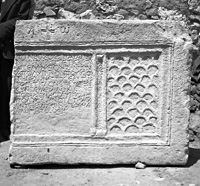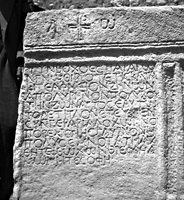 MAMA XI 206 (Axylon)
MAMA XI 206 (Axylon) 
Funerary inscription in verse for Zeno and Aur. None
- Type of monument:
- Funerary inscription in verse.
- Location:
- Çeşmelisebil (Axylon): not recorded.
- Description:
- Limestone slab, broken at left, probably from a sarcophagus. Lines 2-12 of inscription in moulded panel, flanked to right (and presumably to left) by blind scalloped tracery. Line 1 of inscription on upper moulding.
- Dimensions:
- Ht. 1.00; W. 1.26+; Th. 0.18; letters 0.024-0.030.
- Record:
- WMC notebook copy; photograph (1954/42).
- Publication:
- W. M. Calder, MAMA VII xxiii (text only); (Merkelbach and Stauber 2001: 14/02/12).
- Date:
- Fourth or fifth century AD.
Α † Ω
τυνβοχόες παράγω-
ν γνῶθι, βροτέ, τίς κατά-
κιτε· ἀφνειὸν Ζήνων-
5α πολύρηνον πολυβού-
την· ζῶν αὐτὸς ἑαυτῷ
τόδε τίτλον ἔτευξεν
σὺν γεραρῖ ἀλόχῳ ἥν οἱ
πόρε Χρ(ιστὸ)ς Ἰη(σοῦ)ς, Αὐρ(ηλία) Νονη
10πολὺ σεμνοτάτη ἀγα-
θή τε φθωχῶν θρέφθη⟨ρ⟩᾿ ἀ-
μώμη τε σοφή. v.
Line 7: the mason originally inscribed ἔτευτεν; the second tau was subsequently corrected to xi.
Lines 10-12: ἀγα|θή τε φθωχῶν θρέφτηρα | (ἀ)μώμη τε σοφή τε Calder; θρέφθηρ᾿ ἀ|μώμη Merkelbach and Stauber.
As you pass this funerary mound, learn, mortal, who lies buried (here): a wealthy man, Zeno, rich in lambs and rich in oxen. While still living, he constructed this tombstone for himself, along with his reverend wife, whom Jesus Christ provided for him, Aur(elia) None, a most exceedingly holy woman, an excellent nurse of the poor, blameless and wise.





For the scalloped tracery to the right of the inscription, compare the decoration of the sarcophagus of a Novatian presbyter from Laodikeia Katakekaumene (Calder 1923b: 76-81, no.4; Merkelbach and Stauber 2001: 14/06/05). The inscription comprises six hexameter verses, the last of them incomplete. The structure and phraseology of the text are very similar both to MAMA XI 207 (1954/43), another verse inscription in six hexameters, and to the fragmentary MAMA XI 208 (1954/45), both from Çeşmelisebil; all three inscriptions seem to have been composed by the same local poet.
The word τυνβοχόες in line 2 derives from a hapax in Iliad 21.322-3 (αὐτοῦ οἱ καὶ σῆμα τετεύξεται, οὐδέ τί μιν χρεὼ | ἔσται τυμβοχοῆς, ὅτε μιν θάπτωσιν Ἀχαιοί). The interpretation and accentuation of the word was controversial in antiquity (West 2001: 135); to all appearances, the author of this epigram understood it to be an adjective *τυμβοχόης, here used in the neuter (understanding e.g. σῆμα in line 1). Merkelbach and Stauber print τυμβοχος and translate the clause ‘der du mit Spendengüssen vorbeigehst’. The hexameter at lines 4-6 is based on the Homeric ἐν δ᾿ ἄνδρες ναίουσι πολύρρηνες πολυβοῦται (H. Il. 9.154, 296; Hes. Fr. 240.3 Merkelbach-West), with πολύρ(ρ)ηνον (cf. H. Od. 11.257) employed for πολύρρηνα metri causa. In lines 8-9, ἥν οἱ πόρε (in this metrical position) is a standard Homeric idiom (cf. e.g. Il. 1.72, ἣν διὰ μαντοσύνην, τήν οἱ πόρε Φοῖβος Ἀπόλλων; Il. 7.146, 9.667, 11.353, 15.441, 23.92; Od. 5.321, 5.372, 6.228). In line 11, the postulated mason’s error θρέφθη⟨ρ⟩᾿ (i.e. θρέπτειρα, a nurse) is supported by MAMA XI 208 (1954/45), where the deceased woman is described as πτωχῶν θρέπτειραν ἄμ[ωμον (?) - -]ην τε σοφήν τε. For the theme of charity to the poor in Christian funerary inscriptions, cf. Buckler, Calder and Cox 1925: 142-3, no. 125 (Kotiaion), τὸν πτωχοὺς φιλέοντα.
Zeno is described as ‘rich in lambs and rich in oxen’. The Homeric tag reflects the realities of wealth-accumulation in this region. In the Hellenistic period, the economy of this part of the western Anatolian steppe (the 'Axylon', or ‘treeless’ region: Livy 38.28.4, with Mitchell 1993: I 143-7) had been primarily dependent on large-scale grazing (Robert 1980: 257-307; Robert, OMS VII 19-38), but by the Roman imperial period sedentary cereal agriculture existed alongside sheep-rearing throughout the western parts of the plateau (Mitchell 1993: I 148-9).